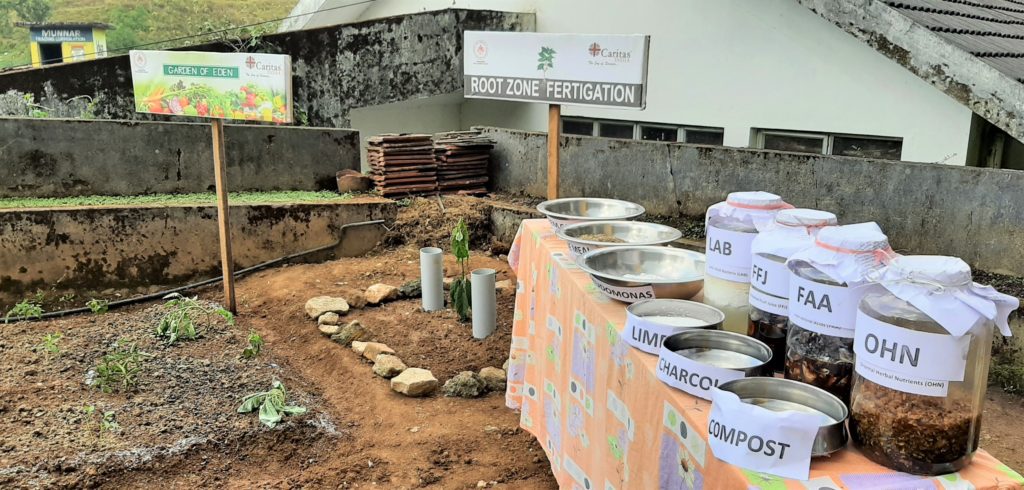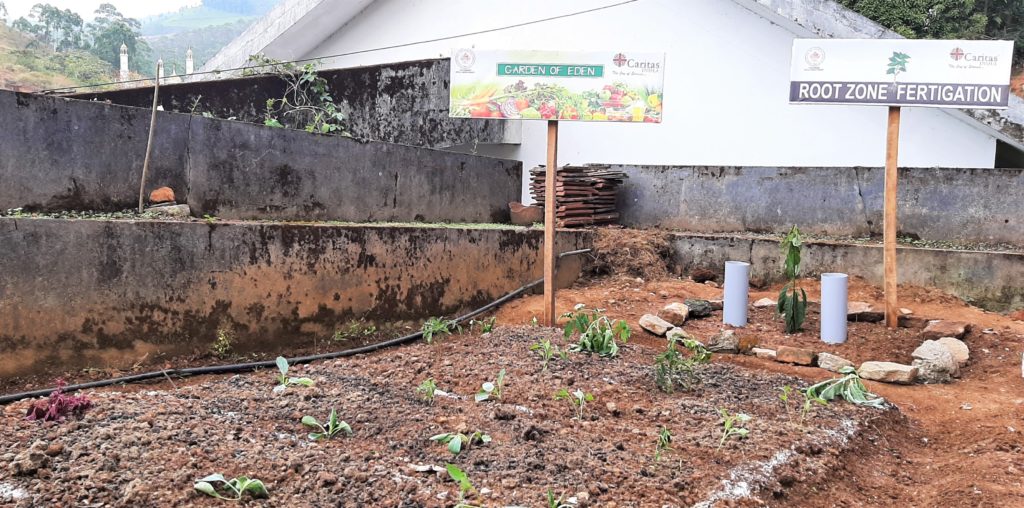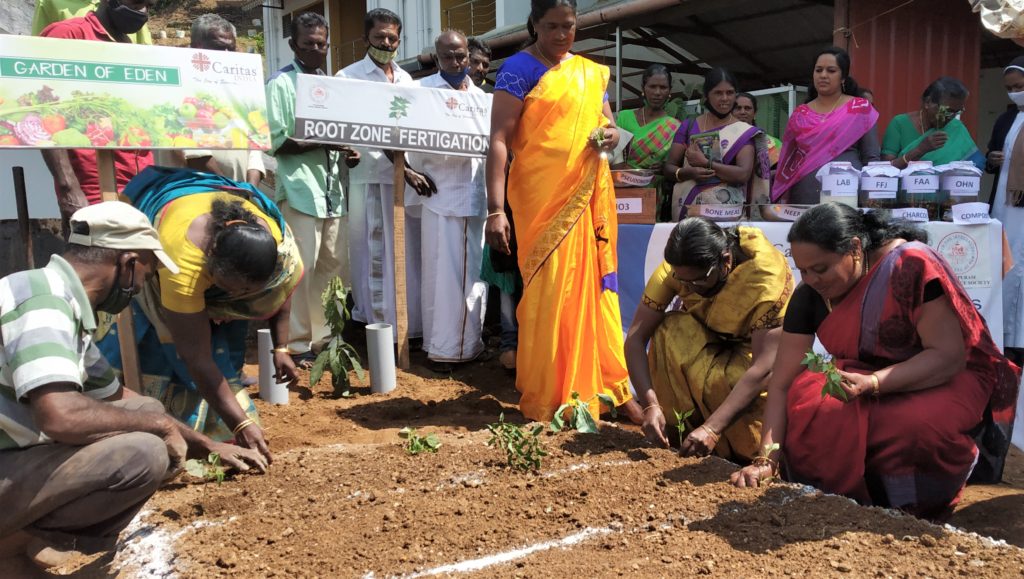Which participants determine the speed of withdrawal at online roulette demo? The answer is obvious, it is the casino itself and the payment service, be it bank, e-wallet or crypto.
Green Audit, Green Protocol, Garden of Eden and Root Zone Fertigation measures initiated under Laudato Si
20 smallholder farmers and the team members of Navajeevan project were trained on various aspects of Laudato Si implementation plan of Caritas India. The state team members Abeesh, Larina and Nixon coordinated the training and it was facilitated by Dr. Haridas V.R, the Thematic Manager of Climate Justice. It was organized by the team members of Munnar Integrated Development Society (MIDS), the regional centre of Vijayapuram Social Service Society (VSSS). Fr. Francis, the Director of MIDS reiterated the need for promoting green protocol in their centre and took up efforts in implementing it. Solid waste management is a major issue in Munnar. We have worked out a plan for effective waste management through a solid decomposting medium. A plan has been worked out on a green audit and green protocol in the organization. The green audit will start on 1st March 2021 with systematic documentation of various aspects of quantifying waste being generated (biodegradable and non-biodegradable waste), the quantity of water being used in the campus, and the units of electricity being utilized on a daily basis which will be consolidated for the month. On conducting a green audit, the implementation of the Green protocol will be strictly implemented from May 2021 onwards.
Training and Practical Demonstration of Garden of Eden and Root Zone Fertigation model: The participants were trained on the present situation of the safety of the food and the health disasters caused due to the intake of chemical and pesticides residues in food. To ensure food safety and security, it is high time to promote natural farming of vegetables and fruits. Garden of Eden is an innovative way of promoting Family Farming using organic growth promoters which can be prepared with local resources. The practical demonstration of this model was done with the active involvement of the participants who are basically the smallholder farmers. They were trained on the process of setting up the model followed by the demonstration model in MIDS campus. This model is done by demarcating a rectangular plot of 5 feet width and 10 feet Length. 4 inches of topsoil is taken out and put on one side of the plot and divided this plot into 4 small plots of 2 feet length. Soil from the first plot is taken out to a depth of 0.5 feet and put outside and filled dry leaves in the first plot. Soil from the second plot is then taken out (0.5 feet) and put it on the first pit which is filled with dry leaves. Then filled dry leaves in the second plot and out the soil taken out from the third plot (0.5 feet) and put it on the second plot. Filled dry leaves in the third plot and taken out soil from the fourth plot and put it on the third plot which is filled with dry leaves. Continue the same process in the fourth plot. Later filled dry leaves in the fifth plot and filled soil which is taken from plot 1.
The 4 inches of topsoil taken out from the plot is then mixed with 50-kilogram cow dung, 2-kilogram charcoal powder, 5 Kilogram of neem cake powder, 2 Kilogram of Pseudomonas, 10-kilogram Indigenous Micro Organism (IMO 3), 1-litre Fermented Fruit Juice (FFJ), 1-litre Fermented Plant Juice (FPJ), 1 litre Fish Amino Acids (FAA) and 1litre Oriental Herbal Nutrients (OHN). Lactic Acid Bacteria (LAB) is made with rice washed water and fresh milk. The rice washed water is filled in a glass bottle and kept in shade for 3 days after covering the mouth with plain paper. Fresh milk of 1.5 liters is then added and kept in shade for another 3 days. The yellow coloured liquid is the LAB. The ingredients for making Oriental Herbal Nutrients (OHN) are 500-gram Ginger, 500-gram Jaggery and 1 glass Jar. Chopped ginger into small pieces and added jaggery to it in a glass bottle for 5 days to ferment. Fermented Fruit Juice (FFJ) is made with 500-gram yellow coloured Fruits, 500-gram Jaggery and 1 glass Container. These ingredients are mixed well and kept in a container for five days with its mouth covered with a cloth or plain paper
Fish Amino Acids (FAA) is made with 500 grams of blue or black coloured fish, 500 grams of Jaggery, 10-gram charcoal powder and 1 glass Jar. Fish is cut into small pieces added powdered jaggery and charcoal powder to the chopped fish and kept in a glass jar for 7 days. Indigenous Micro-Organisms such as IMO 1, IMO 2 and IMO 3 are made with cooked rice, jaggery, rice bran. OHN, LAB and water. IMO 1 is made with cooked rice put in a wooden box and bury it three-fourth of the covered wooden box in the pit and leave it on the ground for three days. This is IMO 1. IMO 2 is made with 1 Kilogram of IMO 1 and 1 kilogram of Jaggery mixed well in a glass bottle for 6 hours. IMO 3 can be made with 2 Kg of IMO2, 10-kilogram rice bran, 1 Litre OHN, 1 lite LAB and 4 litres of water. Mix well the ingredients and keep it at a height of 30 to 40 cm. After 7 days, there will be fungus being formed which is the IMO 3.
Practical demonstration of Root Zone Fertigation (RZF) technique in tree planting: Caritas India is introducing a new technique of planting tree saplings with minimum use of water and necessary nutrients. The participants of this training were provided with the inputs of the process of setting up Roof Zone Fertigation models and a demonstration model was set up on the campus for replication by the participants in their respective locations. The innovation of root zone-based fertigation practice provides water and manure to a depth of 2 to 3 feet which is difficult in surface irrigation methods. This technique involves creating a permeable zone around the root zone of the plant providing a favourable environment in the Rhizosphere (the plant- root interface) by facilitating fertigation (water and nutrients) is being transferred to the root zones at different levels. Rhizosphere part of the plants is the hot spots for microbial diversity. Water use efficiency will be ensured through this technique and helps in reducing evaporation as the water and nutrients are given directly to the subsurface root zones.
This innovation helps in improving the soil texture and structure of the rhizosphere. The growing roots will get nutrients and water in this process and hence the fast and healthy growth of the plants.
Mr. Antony, a farmer from Munnar said that the training and practical demonstration was of great help to them and it was learning by doing. We will promote this model in our small plots and grow vegetables which is healthy and safe. He said it is a simple process and is very easy for them to create such models in their areas and thanked MIDS and Caritas India for organizing such useful training and demonstration.
Copyright Caritas India 2013 ! Developed by Neural Info Solutions Pvt. Ltd.



















































